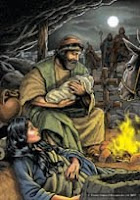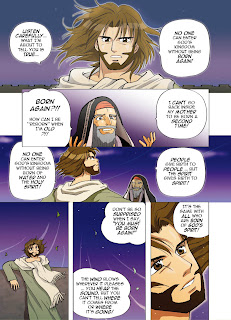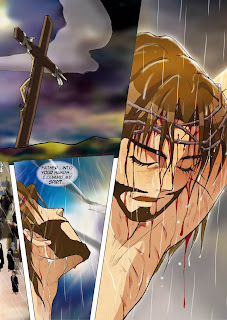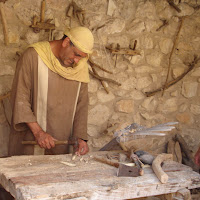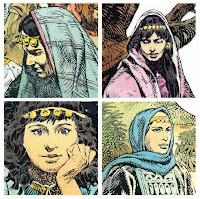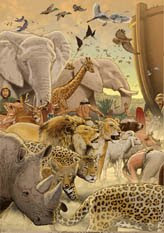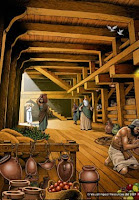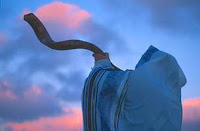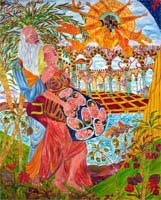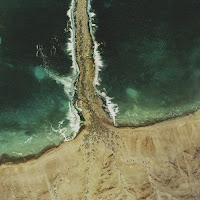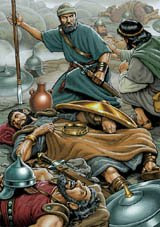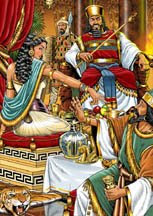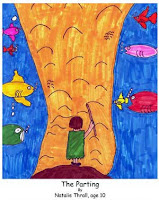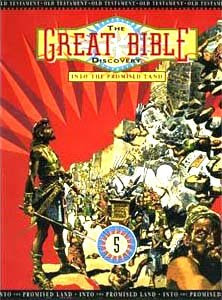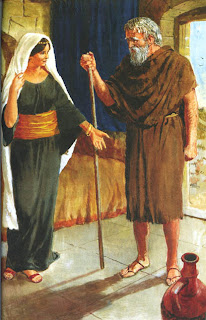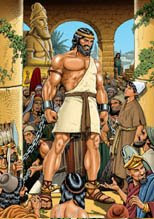I would like to take this opportunity to introduce you to a new visitor to the Bible illustration blog, whose recent comments on the blog I know many of you have found incredibly helpful. Nahum HaLevi, (who is also a Levite), is a Jewish Bible artist based in the U.S. His paintings can be found at Nahumhalevi.com. Each painting on Nahum's website is accompanied by a highly detailed description which, apart from being a fascinating read, reveal Nahum's immense knowledge of the Torah. I asked Nahum if he would consider writing a short post for the B.I.B describing his Bible Art. He kindly agreed.  Painting the Hebrew Bible: Words and images, by Nahum HaLevi.
Painting the Hebrew Bible: Words and images, by Nahum HaLevi. The thrust and focus of my paintings is an attempt to grasp the transcendent meaning of the Hebrew Bible, and by extension to use art as a tool to try to understand the underlying nature, structure and essence of the universe, in other words to apprehend God. As a template for this process I attempt to visually express the biblical narrative by deriving multiple images from multiple translations of the original Modern Hebrew text, and at times retranslate the words back into ancient Hebrew and further back into proto-Sinaitic pictographic Hebrew.
Biblical Hebrew contains many words with multiple meanings, a testament to its very early and ancient origins. The meanings of some Hebrew words can be radically changed by a mere alteration of pronunciation, or textual context, or even by a single letter substitution. These linguistic elements have led to a wealth of literary interpretations.
Many of my paintings combine the multiplicity of meanings of the Hebrew biblical text with the multiplicity of visual images derived from these different literary interpretations of scripture thereby resulting in combined visual-literary stories that are not possible by isolated pure literary or visual analysis.
For some paintings I fuse images and words from disparate scriptures thereby creating fusion imagery of disparate biblical characters and concepts in different historical space-time coordinates into one holistic story. By retaining fragments of the different stories, each individual story is told, and a new creative story is told for the first time, providing multiple layers of meaning to the original stories.
In some paintings , I use the principle of taking stories of individual characters from sequential chronological periods of their lives and jumbling them up into one narrative as though each story is a single point in the space-time continuum, and lives not only in the past or future, but in the never ending present.

One example of this is in the painting
"Moses : Rock 'N Rage".In this painting I have fused the young Moses who hits and kills the Egyptian taskmaster drawing out blood, with the older Moses who hits the rock in the desert, drawing out water quenching the Israelite's thirst. Also visually fused in this painting , are the Egyptian taskmaster and the rock who spew out blood and water as a result of being hit by Moses. The inspiration for this imagery comes from the common Hebrew word used in both stories for hitting- "Vayach"- "and he hit", either the Egyptian or the stone.
The visualized simultaneity of two separate historical events combined with the simultaneous sequential chronological unfolding of both separate events, confuses our natural understanding and perception of linear time, providing us with a more accurate perception of the malleable bending of the space-time continuum, and thus fills us with an other worldly ethereal transcendental feeling.

In some paintings I attempt to create a cinematic sensation of time moving both forwards and backwards on a two dimensional canvas by having individuals moving multiple arms and legs in different sequential geometric and spatial planes. I have used this technique in
"Moses : Rock 'N Rage", and even more so in
"The School of Shamgar".

In a similar vane in the painting
"The Amramovitz Family: Teamwork", I portray the infant Moses with a beard, fusing two of Moses' time coordinates; that of his infancy with that of his adulthood visualizing the simultaneous separate existences of these images within the space-time continuum, as well a providing a sensation of time rapidly moving forward or backwards from infancy to adulthood, depending on one's perspective. Again this confuses our perception of ordinary space-time and transports us into another realm of thought which transcends the ordinary laws of physics as we perceive them.
In my paintings I also like to convey a sensation of synesthesis. Synesthesis is a neurological condition where certain individuals crisscross and confuse different senses, for example, some people can taste or hear colors. Certain people can see sounds. This is what is conveyed in the Bible , at Mount Sinai, when the Ten Commandments were given, and God descended on the mountain, that all Israel saw the sounds of the shofars (trumpets) and the sounds of thunder. I have conveyed this in my painting
"Shavuot" by

drawing musical notes in the background. Similarly in many of my paintings I hope they are appreciated by utilizing sensory modalities other than sight, and I hope that you not only see the paintings, but hear their conversations, and the music they are playing, and hence I hope you fuse sight and sound, that you see and hear illuminated symphonies, and that you are momentarily transported and enjoy a separate reality.
By providing and fusing multiple scriptural word definitions and multiple images derived from them, in many paintings you might see simultaneous multiple image possibilities, and you might simultaneously sense that you are in the past, present or future, or all three, You might sense that you are at location X, or Y, or simultaneously feel that you are at both locations. When you read a word or several words and sentences, you might simultaneously understand multiple definitions and explanations. If you do all that, you might appreciate a greater totality of the universe, or at the very least will understand the limitation of our human brains when viewing things statically.
I personally view every two-dimensional biblical canvas as a small bird's eye view of the vast space-time continuum. Different splashes of paint and letters all represent different points scattered in space and time, existing separately and yet simultaneously, all splayed out in a microcosm before our frail visual fields allowing us to grasp past, present and future in simultaneity, as they twinkle, coexist and meld into one unified coherent whole giving us a multifaceted perception of infinitely changing realities- dare we say a fragmentary glimpse of God.
